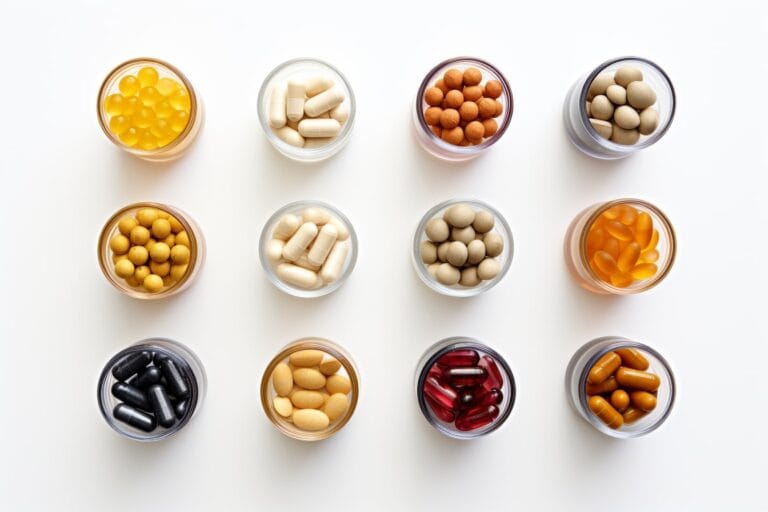Diet & Fasting After 50: Boost Health & Longevity
As we hit the milestone of 50, our bodies start to respond differently to diet and exercise. It’s a time when maintaining a healthy lifestyle becomes not just advisable but essential. We’re here to guide you through the nuances of diet and fasting after 50, ensuring you’re equipped with the knowledge to thrive in this new chapter.
Understanding the importance of tailored nutritional strategies as we age is crucial. Our metabolism slows, and our nutritional needs shift, making it vital to adapt our eating habits. Fasting, when done correctly, can offer a multitude of health benefits, including improved metabolic health and increased longevity. Let’s dive into how we can navigate these changes together, ensuring we’re not just aging, but aging well.
The Importance of Diet and Fasting After 50
As we hit the big 5-0, it’s no secret our bodies aren’t exactly as we remember from our roaring 20s. Metabolism takes a slow dive, and suddenly, those late-night snacks stick around longer than they used to. It’s why tweaking our diet and considering fasting isn’t just smart; it’s essential for staying on top of our game.
Let’s get real about the food we fuel up on. Our bodies are shifting gears, demanding nutrient-dense foods that pack a punch without the extra calories we can’t shake off as easily. It’s not about eating less but upgrading our grub with more proteins, fibers, and vitamins. We’re talking lean meats, vibrant veggies, and fats that are good for the heart – think avocados and nuts. And hydration? Non-negotiable. Downing enough water keeps everything from our metabolism to our mood running smoothly.
But here’s the kicker: fasting. It’s not the latest fad diet but a time-tested tool that, when done right, can reboot our system. We’re seeing evidence that strategic fasting isn’t just about weight control; it’s about giving our bodies the reset button for better metabolic health and longevity. Whether it’s intermittent fasting or time-restricted eating, the key is consistency and listening to our bodies. It’s not a one size fits all – it’s about finding what syncs with our lifestyle and sticking with it.
Here’s the bottom line: as Gen Xers, we’re at a pivotal point where the right moves can redefine our health trajectory. Diet and fasting aren’t just about extending our lifespan; they’re about enhancing our healthspan, ensuring we’re not just living longer but living better. And let’s not forget, making savvy diet and fasting choices now can also be a boon for our wealth, avoiding hefty health expenses down the line.
So, as we navigate these golden years, let’s embrace the changes, tweaking our diets and considering fasting as tools in our arsenal for aging like the fine wine we are.
Understanding the Aging Process
As we journey past 50, diving deep into what makes us tick and how we can keep ticking longer and healthier becomes paramount. We’re not just looking to add years to our life but life to our years, and understanding the aging process is the first step in this quest. Let’s break down what’s happening to us as we embrace these golden years.
Changes in Metabolism
Remember those days when we could devour a late-night pizza without a second thought? Well, those days are taking a backseat as our metabolism isn’t what it used to be. As we age, our metabolic rate slows down considerably, meaning we can’t burn calories as quickly as we did in our youth. This slowdown is partially due to a decrease in muscle mass, a natural part of aging.
But it’s not all doom and gloom. We can counteract this by:
- Increasing our physical activity: Regular exercise, especially strength training, can boost our metabolism by building muscle mass.
- Eating small, frequent meals: Keeping our metabolism active throughout the day can help us manage our weight more effectively.
Nutritional Needs
Our nutritional needs undergo a transformation as well. It’s not just about what we eat but how our bodies process it. With age, our bodies become less efficient at absorbing certain nutrients, making it crucial to adjust our diet. To stay on top of our game, we need to focus on:
- Calcium and Vitamin D: Essential for bone health, especially important as we become more prone to osteoporosis.
- Fiber: Keeps our digestive system in check and helps us manage our weight.
- Omega-3 fatty acids: Combat inflammation, a key ally in fighting chronic diseases often seen in older adults.
Adjusting our diet to meet these changing needs isn’t just about adding years to our life; it’s about adding vitality and energy to every day.
Managing Weight
Let’s face it, managing our weight becomes a tougher battle with each passing year. But it’s a battle worth fighting. Keeping our weight in check not only helps us look and feel our best, but it also significantly reduces our risk of chronic diseases such as diabetes, heart disease, and certain cancers.
To effectively manage our weight, we should focus on:
- Eating nutrient-dense foods: Opt for foods rich in nutrients but low in calories to feel fuller longer.
- Monitoring portion sizes: It’s easy to overeat, even healthy foods. Keeping an eye on portions can help us avoid unnecessary calories.
- Staying active: Combining cardiovascular exercises with strength training can help us maintain a healthy weight and muscle mass.
Embracing these strategies not only helps us manage our weight but also boosts our overall health, keeping us fit, active, and ready to enjoy all that life has to offer beyond 50.
Benefits of Intermittent Fasting
As we navigate our 50s and beyond, we’re all about making smart choices that amplify our health and wealth. We’ve gathered here to delve into how intermittent fasting (IF) stands as a game-changer in our quest for a longer, healthier life. It’s not just about what we eat but when we eat that’s revolutionizing our approach to wellbeing after 50.
Boosts Cellular Health
One of the most compelling benefits of IF is its knack for enhancing cellular health. This may sound high-tech, but it’s all about giving our cells the chance to clean house. When we fast, our bodies initiate a process called autophagy. Autophagy is like a tune-up for our cells, removing damaged components and making room for new, healthier ones. Studies have shown that increased autophagy is linked to a reduction in age-related diseases, which could mean more years to enjoy our hard-earned freedom and possibly less spent on healthcare—an appealing thought for our savvy generation.
Reduces Inflammation
Additionally, IF has been shown to help reduce inflammation—a root cause of many chronic diseases that can become more prevalent as we age. Inflammation is like a silent alarm going off in our bodies, indicating something is amiss. Keeping this in check is crucial for maintaining our zest for life beyond 50. By incorporating fasting into our lifestyle, we’re not just cutting calories; we’re influencing our body’s inflammatory responses, potentially warding off conditions that could cramp our style during what should be our golden years.
Improves Insulin Sensitivity
Finally, let’s talk about sugar—not the sweet stuff we may sneak into our morning coffee but blood sugar. Managing blood sugar levels is key as we age, and IF can play a pivotal role in this. By improving insulin sensitivity, fasting helps our bodies better process glucose. This not only reduces the risk of type 2 diabetes but also supports sustained energy levels and weight management. For us, that means more vitality to pursue our passions and maintain our independence for longer.
In a nutshell, intermittent fasting isn’t just another diet trend; it’s a lifestyle adjuster that holds the promise of enhanced cellular health, reduced inflammation, and better blood sugar control. These aren’t just benefits; they’re our ticket to aging on our terms, staying sharp, agile, and ready to take on whatever comes our way. Let’s continue exploring how this powerful tool can be part of our strategy to thrive in the years ahead.
Tips for Healthy Eating After 50
Eating right isn’t just a youth’s game; as we age, it becomes crucial to our health and longevity. With our bodies undergoing changes, especially after hitting that big 5-0, adapting our diet can help us not only feel better but thrive. Let’s dive into some smart eating strategies that can make a significant difference.
Focus on Whole Foods
Remember the days when we could eat anything and seemingly not gain a pound? Well, those days are a bit behind us, but that doesn’t mean we can’t enjoy our meals. Shifting our focus to whole foods is a game-changer. What does this mean for us? It is all about selecting foods as close to their natural state as possible. Think fresh fruits and vegetables, whole grains, and lean proteins.
- Why Whole Foods? They are high in nutrients and free of processed trash that can be harmful to our health.
- Easy Swaps: Instead of white bread, opt for whole grain. Swap sugary snacks for a piece of fruit.
Get Enough Protein.
As we become older, it becomes more difficult to maintain muscular mass. Protein is our ally here, as it helps us maintain our strength and combat muscle loss, which can slow us down.
- How much? Aim for 1.2 to 2.0 g of protein per kilogram of body weight every day. This may differ depending on exercise level and health needs.
| Age Group | Protein Requirement (g/kg body weight) |
|---|---|
| 50-65 | 1.2-1.5 |
| 65+ | 1.5-2.0 |
- Protein Sources: Choose lean meats like chicken or turkey, as well as omega-3-rich fish, beans, and lentils. Do not forget about dairy; yogurt and cheese are fantastic sources.
Consume Healthy fats.
Fats were once vilified, but we have since discovered that good fats are vital, especially for our age group. They promote brain health, aid in nutrient absorption, and help our hearts function properly.
- Types of Healthy Fats: Look for unsaturated fats found in olive oil, avocados, nuts, and fatty fish like salmon and mackerel.
- Benefits: Besides providing energy, these fats help with managing inflammation, which is crucial for preventing chronic diseases that can become more of an issue as we get older.
Incorporating these principles into our everyday routine does not have to be a chore. It is about making tiny, attainable changes that are consistent with our lifestyle. After all, we do not only want to live longer lives; we want those years to be full of vigor.
The best diets for older adults
As we get beyond our 50s, it is critical to identify diets that not only address our bodies’ demands but also resonate with our generation’s attitude. We are all about making informed decisions that not only extend our lives but also keep our health bright and fulfilling. Let us look at a few diets that reach the sweet spot for us.
Mediterranean diet
The Mediterranean diet is more than just a diet; it is a long-standing lifestyle choice with proven results. This diet, based on Mediterranean eating practices, emphasizes:
- Plenty of fruits, vegetables, and whole grains
- Healthy fats like olive oil over butter
- A good chunk of legumes, nuts, and seeds
- Lean protein from fish and poultry, with red meat taking a back seat
Why does it resonate with us? Aside from being delicious, it is also heart-healthy and promotes cognitive function—two things we are looking into. According to studies, following the Mediterranean diet can cut the risk of heart disease, improve cholesterol levels, and lessen the chance of Alzheimer’s. It is about eating with friends and family, getting more exercise, and stressing less, all of which coincide with our objective of living well and thriving.
The DASH Diet
Next, we have the DASH (Dietary Approaches to Stop Hypertension) Diet, which was designed expressly to manage high blood pressure, a prevalent worry among many of us as we age. This diet focuses on:
- Reducing sodium intake while boosting nutrients like potassium, calcium, and magnesium
- Focusing on fruits, vegetables, whole grains, and lean meats
- Limiting sweets, sugary beverages, and red meats
The DASH diet is not only effective at lowering blood pressure, but it has also been related to a lower risk of heart disease and stroke. Furthermore, it is adaptable enough to fit into our everyday activities without compromising the pleasures of eating good cuisine.
Both the Mediterranean and DASH diets provide frameworks that emphasize thoughtful choices rather than restriction. They are not fads, but rather sustainable dietary habits that can help us achieve our health goals and stay in the game longer and stronger. Embracing these diets is like investing in our future selves, guaranteeing that we not only live longer but also live well, with the energy to appreciate our many adventures.
Intermittent Fasting Methods:
In our search for a bright and healthy life after 50, we are looking into tried-and-true methods like intermittent fasting. This is not about skipping meals at random; rather, it is about developing strategic eating habits that can have a substantial impact on our metabolic health, weight control, and overall well-being. Let us look at a few common ways that cater to our generation’s need for flexibility and effectiveness.
The 16/8 Method
The 16/8 approach, commonly known as the Leangains program, involves fasting for 16 hours and eating within an 8-hour window. For many of us, this means missing breakfast and eating lunch as our first meal of the day. It is a simple method that fits well with our hectic existence, whether we are running enterprises, enjoying retirement, or anything in between. The main advantages are weight loss and better insulin sensitivity. Here’s why it is a hit with our audience:
- Flexibility: We choose our 8-hour window, making it a breeze to fit social dinners or late brunches into our schedule.
- Simplicity: No need to obsess over calorie counting or eliminating food groups.
- Effectiveness: It’s shown to aid in weight management and enhance metabolic health, crucial as we age.
Alternate Day Fasting
The next option is alternate day fasting (ADF), which is exactly what it sounds like: a day of normal eating followed by a day of fasting or taking extremely few calories (about 500). It is a little more difficult, but it pays off for those of us wanting to boost our weight reduction and lifespan goals. ADF excels in its capacity to
- Boost weight loss: By creating a calorie deficit over time, we’re likely to see the pounds drop.
- Enhance cellular repair processes: Fasting days kickstart autophagy, our body’s way of cleaning out damaged cells and regenerating new ones.
- Improve metabolic health: Regular ADF can lead to reductions in blood sugar levels and decrease inflammation.
Both the 16/8 method and ADF provide paths to better health that are consistent with our generation’s values of hard effort, practicality, and a desire for significant outcomes. We believe in making informed, effective decisions that pay off in the long run, and these intermittent fasting approaches suit the criteria wonderfully.
The importance of staying hydrated.
As we approach our fifties, we get a little more wisdom, and one aspect of that insight is realizing the importance of water in our health strategy. We are not simply talking about satisfying thirst; we are going to look at how being hydrated is an essential component of a healthy aging plan.
Hydration is more than just drinking water; it is about maintaining the proper fluid balance that our bodies require to function optimally. As we age, our body’s water capacity diminishes, making us more vulnerable to dehydration. This is not simply a summer issue; it is a year-round priority. Dehydration can cause a variety of health problems, including urinary tract infections and kidney stones, and it can even worsen chronic illnesses like kidney disease.
Let us split it down using numbers:
| Age Group | Estimated percentage of body water. |
|---|---|
| Newborns | 75%-78% |
| Adults | 55%-60% |
| Older Adults | 50% |
Seeing the drop in body water content as we age explains why hydration is even more important beyond 50.
Remember when we could party all night and recover the next day? Our resilience may not be as strong as it once was, but our savvy has not diminished. Adding hydration to our daily routine entails more than simply drinking eight glasses of water. It is about recognizing the signals our bodies send us, and realizing that sometimes we think we are hungry when we are truly thirsty.
To maintain proper hydration, we need to:
- Start the day with a glass of water.
- Drink even if we do not feel thirsty.
- Include water-rich foods in our diet, such as fruits and vegetables.
Staying hydrated improves our metabolism, keeps our skin smooth, and boosts our overall vitality. It is a simple but useful tool in our effort to age gracefully and keep our health. Let us make sure our hydration game matches our future plans.
Conclusion
To embrace the changes that come with aging, we must be careful of our nutritional and fasting practices. We have seen how eating more nutrient-dense meals and staying hydrated can improve our health and vigor after 50. Furthermore, including strategic fasting into our daily practice represents a viable option for improving metabolic health and promoting lifespan. It is all about achieving the perfect balance and consistency that suits our individual lifestyles. By doing so, we not only age gracefully, but also vitally. Let us resolve to making these healthy habits a part of our daily life so that we can thrive in our golden years.







